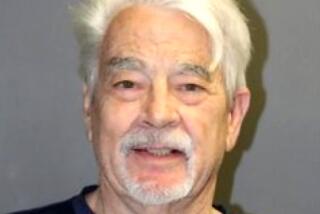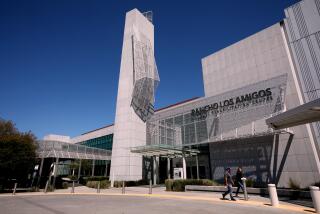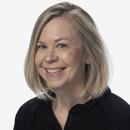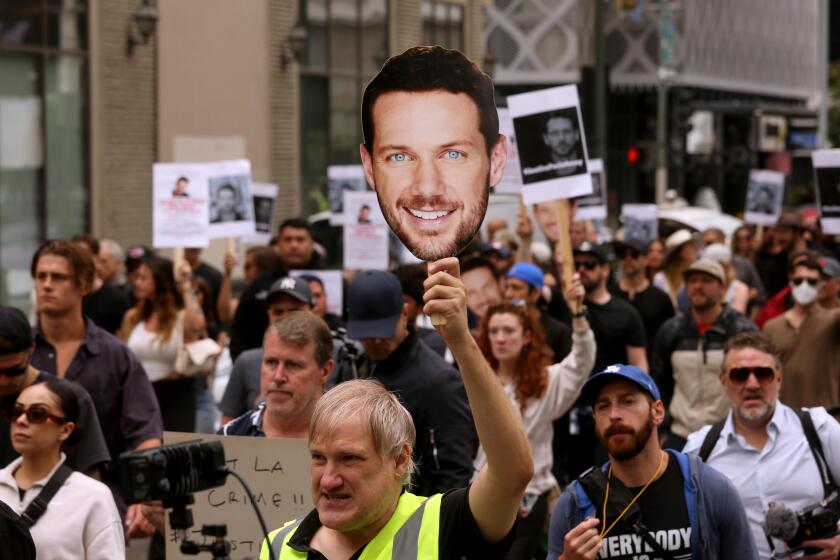Must Reads: How George Tyndall went from USC gynecologist to the center of LAPD’s largest-ever sex abuse investigation
Dr. George Tyndall arrived on the USC campus in the summer of 1989. The university had advertised for a full-time gynecologist for the student health center, and Tyndall, then 42, was an enthusiastic candidate.
“My mission will be to do everything I can to help Trojan women avoid the many preventable catastrophes that I have seen,” Tyndall declared during the job interview, according to a written account he provided to The Times. “And I will do so for as long as I am mentally and physically able, hopefully well into my 80s.”
USC offered a salary that was a fraction of what Tyndall’s peers elsewhere earned, but he saw rewards beyond money. The job, he would later say, allowed him to shepherd female students safely to womanhood, steering them around sexually transmitted diseases, unplanned pregnancies and other hazards.
“The way I saw patients at USC — I would think to myself, ‘This is my chance. She hasn’t made any mistakes yet,’” Tyndall said in an interview this spring.
Many who encountered the physician, however, saw him as less a voice of medical authority than as an eccentric who bewildered and, over time, ultimately alarmed those around him.
The 71-year-old physician’s life is now under intense scrutiny as detectives probe allegations that Tyndall sexually abused hundreds of patients over nearly three decades at USC, part of the largest-ever L.A. Police Department sex crimes investigation with a single suspect. Investigators are grilling his co-workers and poring over his possessions, including hard drives seized from his cluttered home and photos of unclothed patients found in a rented storage unit.
Tyndall has denied all wrongdoing. These days a team of lawyers speaks for the doctor, who was removed from the clinic in 2016. But before the allegations became public this spring, Tyndall met with Times reporters several times at a city park in L.A. and shared details about his life and career.
“I was controversial from Day One,” he said of his time at USC’s student health clinic.
FULL COVERAGE: USC former gynecologist Dr. George Tyndall accused of inappropriate behavior »
The interviews with him and more than two dozen associates paint a portrait of a man of obvious intelligence who excelled in college, medical school and the U.S. Navy, but struck many as socially awkward and sometimes overbearing.
He spoke to co-workers and patients like a lecturing professor. He labeled himself as a germaphobe, though his office was an unsanitary jumble of medical waste and boxes. To find a wife, he went to the Philippines repeatedly, and ultimately married a Filipina 25 years his junior.
Perhaps his most long-term and significant bond was with USC, where he worked for 27 years. Although he never attended or taught at the university, Tyndall reveled in its academic reputation and prodded patients to respect their school as “the center of the world.” He could recite the contributions of university presidents and provosts as if they were figures in a U.S. history textbook.
Even after hundreds of alumnae came forward with allegations against Tyndall, USC remained central to his identity. In a May letter to The Times criticizing its coverage, he promised that when the true story came out, most “Trojans are going to be very proud of this particular member of the Trojan Family.”
A love for the Philippines
When he arrived at USC, Tyndall had just finished his residency after a roundabout way to medicine. Born and raised in Plattsburgh, a city in upstate New York near the Canadian border, he was one of five children.
He enrolled at the State University of New York Plattsburgh but dropped out in 1967 to enlist in the Navy. Signing up allowed Tyndall to avoid the Vietnam War draft and a possible infantry assignment. The Navy sent him to the Defense Language Institute in Monterey to study Vietnamese, then in high demand for American intelligence efforts. He graduated with honors and was stationed in Manila where he worked as a crypto-linguist.
His time in the Philippines sparked a lifelong love for the country and its people. Tyndall said in interviews that he felt as if he had been Filipino in a past life and recalled that learning Tagalog was like rediscovering a language he already knew.
Honorably discharged from the Navy in 1971, Tyndall returned to SUNY and graduated summa cum laude. He joined the U.S. Customs Service as an enforcement officer at Los Angeles International Airport but made it clear to colleagues that it was only a stop off before medical school in the Philippines.
“He talked about working every overtime assignment he could...because he was going to take his money over there and get his doctor’s certificate,” said retired customs officer Terry Kennedy, who often chatted with Tyndall as they waited for delayed planes.
In 1980, Tyndall began medical school at the University of the East, Ramon Magsaysay Memorial Medical Center in the Philippines. Classes were conducted in English and other Americans also attended.
Fellow medical student Rainier Umali said Tyndall stood out among their classmates for his age and his height. He stands well over 6 feet.
Umali, now a psychiatrist in Manila, described Tyndall as exceptionally smart and friendly. He said Tyndall seemed taken with Filipinos’ emphasis on family. He recalled one conversation in which his classmate marveled at how local families lived together in one room.
“He said, in case he gets married, he’ll raise his children like Filipinos do,” Umali said.
After three years, Tyndall transferred to the Medical College of Pennsylvania, now Drexel University College of Medicine. Tyndall said that while his classmates caroused, he was in his room studying. At graduation, he won a prize for excellence in psychiatry and was elected to a national honor medical society, Alpha Omega Alpha.
He went on to an obstetrics and gynecology residency at Kaiser’s Sunset Boulevard hospital, a program he said admitted just five physicians out of more than 500 applicants.
At Kaiser, he delivered babies, performed hysterectomies and treated cancer patients. In the end, he found much of the work depressing, he said. Patients were often old and suffering from cancer, sexually transmitted diseases and other illnesses that might have been avoided with better medical care.
When he wished aloud for a career where he could focus on preventative care, a colleague responded, “Student health,” Tyndall recalled in an interview. Soon after, he said he saw a classified ad for the job at USC.
At the university clinic, he was given one of the largest offices, complete with a private bathroom, access to a rear stairwell and a beautiful view of the campus. The office assignment rankled colleagues, Tyndall said in the interviews.
Tyndall was the first and only full-time gynecologist at the clinic. He made it clear to doctors, nurses and patients that he considered himself an authority on women’s health and sometimes referred to his medical school honor society as evidence of his expertise. But some colleagues noted that he was not board certified, a standard step for many gynecologists.
One reason USC hired Tyndall, he said in an interview, was his ability to perform colposcopies, a procedure that looks for disease on the cervix or vagina. Some of these exams were photographed, and his use of cameras led to some of the first complaints against him by colleagues and patients.
An undergraduate reported him in 1991 for improperly photographing her, according to a sworn affidavit provided by her attorney. The woman, identified only as Jane Doe, said Tyndall initially took close-up photos of her genitals, but as he walked away from the exam table, she wrote, the doctor “began taking full body pictures and of my private area…”
She said she complained to the clinic’s medical director who forced Tyndall to destroy the images, she wrote. Tyndall has said through his attorney that he only photographed patients with their consent and for legitimate medical reasons.
In these early years at USC, Tyndall was a newlywed and his wife occasionally visited the clinic. They had met through a matchmaking service Tyndall had used to find a Filipina bride, said Sharyn Bruno, whose late husband grew up with Tyndall.
He traveled to the Philippines often and eventually proposed to Daisy Patricio, a young woman from the southern island of Mindanao. Public records indicate that when they married, she was in her late teens or early 20s. He was in his 40s.
The two wed at Bruno’s Corona home in front of 20 or so guests, who dined on cake and Chinese food, Bruno said. The couple obtained a confidential marriage license, an option in California that prevents anyone other than the spouses from viewing the document, and the date of the ceremony is not clear. No family members attended, Bruno said. Tyndall had a photography hobby and he snapped so many photos that day that neighbors phoned police, fearing the noise from the flash was gunfire, according to Bruno and another wedding guest.
Patricio spoke English fluently and seemed to adjust well to married life in the U.S., Bruno said. She and Tyndall lived in an apartment he had purchased near Lafayette Park in Westlake. The couple rode on his motorcycle, took trips to Disneyland and enjoyed eating out with Bruno and her husband, Bruno said. They returned to the Philippines to visit her relatives and, according to property records, purchased a single-family home in Davao City, Mindanao’s capital, about a decade ago.
In her visits to the clinic, Patricio spoke little, but Tyndall talked about their relationship often to both patients and staff, former co-workers said. After the 1992 riots reached the edge of Westlake, Tyndall told colleagues that Patricio did not feel comfortable venturing out in the neighborhood alone. Many days he left work to bring her lunch, the former colleagues said.
Tyndall spoke openly about the apartment’s cluttered state. He said there were so many boxes, books and papers in his home that he and his wife could not use the living room and had to eat dinner on their bed.
When nursing supervisor Cindy Gilbert complained about the cluttered state of his office, she said, Tyndall replied, “This is nothing. You should see our house.”
He told her his storage unit was filled to capacity and the car he parked in the USC lot was also stuffed with papers and boxes. The only open area was the driver’s seat, two colleagues recalled.
Dr. Howard Mandel, a Westside gynecologist who worked part-time at USC, said Tyndall seemed to admire the art of filmmaking.
“He sometimes talked about film and TV or screenwriting,” Mandel added.
Another colleague recalled Tyndall saying that he and Patricio enjoyed filming “skits” in their bedroom.
Tyndall and his wife embarked on a photography business in 1992, according to public records. In ads in the Yellow Pages, Glamourlight Photography offered traditional services, such as acting headshots and family portraits, along with “boudoir” shots — intimate and erotic images of women in lingerie.
Patricio worked as Glamourlight’s makeup artist, according to a later bankruptcy filing.
Tyndall pitched his business to at least one patient, according to a woman who graduated in 1993 and is now suing the doctor and USC.
The alumna alleged in a lawsuit that during an appointment in her freshman year, Tyndall pulled out a photo of a scantily clad Asian woman.
“Would you consider doing something like this?” the former patient, who spoke on the condition of anonymity, recounted Tyndall asking. The woman, who is Chinese American, said in an interview, “When I caught his drift, I realized it was a proposition and left in a hurry.”
“Dr. Tyndall adamantly denies that any patient of his was asked to pose for ‘boudoir photography,’” his criminal defense attorney, Leonard Levine, said in a statement.
He and Patricio declared bankruptcy in 1997. At the time, Tyndall’s annual salary at USC was $110,000. In court records, the couple listed Tyndall’s outstanding student loans and credit card bills among their debts. Glamourlight continued listing in the Yellow Pages until 2008. The current state of the business is unclear.
When police raided Tyndall’s storage unit in June, detectives found a mountain of pornographic videos and photographs, some showing the doctor having sex with women. Alongside them was a smaller set of images showing patients naked during exams.
Levine, his attorney, has said the photos were taken with patient consent for medical reasons. The physician moved the photos to the storage unit in 2013 when the student health center relocated to a new building on campus, Levine said in a statement.
The photos “were never shown to, or viewed by anyone, including Dr. Tyndall, after they were originally taken, decades ago,” Levine said.
A doctor with an eccentric style
From the moment patients entered Tyndall’s office, they could tell he was different.
His wardrobe was a rotation of stretched-out slacks, clogs and long embroidered shirts known in the Philippines as barongs. If a student tried to shake his hand, he offered a business card instead, professing to be “a germaphobe.” If I get sick, I won’t be able to treat Trojan women, he explained. He carried a hand towel to open doors, press elevator buttons and turn off faucets.
The state of his office often seemed at odds with his sanitary concerns. Colleagues said it was often foul-smelling and littered with soda cups, take-out containers and an overflowing bin of medical waste. He examined yeast infection specimens at the same desk where he ate lunch and counseled young women, they said.
Tyndall took his time with patients -- even when the waiting room was full. An appointment for birth control often turned into a lengthy science lesson with the physician proffering diagrams of the female anatomy and laminated sheets listing various prophylactic options.
Some people valued this approach and asked for him again and again. Michelle Ward saw Tyndall regularly from 1998 to 2004, when she was getting her doctorate in clinical neuroscience. She said she was initially disconcerted by what she called his “homeless” appearance, but he soon won her over with deeply researched explanations and advice. She recommended him to other women.
“I never felt anything perverted, not for an instant. [It was] the opposite of that. It just felt like I was in there with a professor, a quirky, nerdy, unusual, reclusive, eccentric professor,” said Ward, a jury consultant for an L.A. firm.
She said, however, that she takes the accusations of abuse seriously and believes the allegations should be thoroughly investigated.
By his own account, Tyndall took a particular interest in treating international students, especially those from China. Tyndall said he attempted to empathize with his foreign patients and visualized himself in their shoes.
“I try to imagine I’m from China,” Tyndall said in an interview. In falsetto, he imitated a potential patient: “I’m 5-foot-2. My English is not good. Maybe I’m scared by the tall man.”
Tyndall acknowledged that his colleagues were suspicious of his solicitousness of Asian patients.
“In their mind, I’m a pervert but clients are signing up and begging to be seen by me,” he said. “It caused jealousy among medical assistants.”
Tyndall sometimes spoke to clinic colleagues about racial issues and shared his political opinions.
In his hours away from the USC student clinic, he tapped out letters to newspaper editors. Publications including The Times printed more than 30 letters in the 1990s and 2000s. Many were critical of illegal immigration. In a 1993 letter to the New York Times, he bemoaned laws that welcomed “individuals who because of language problems and lack of skills have almost no chance of achieving the American dream.”
On a few occasions, he was accused of making racist remarks in the clinic. Undergraduate Shernae Hughes said she complained in 2016 after she saw him for birth control.
“I shared that I was interested in opening businesses in low-income black communities,” Hughes, who graduated in May, testified at a June state Senate hearing. “Dr. Tyndall responded, ‘You should open up more clinics so they can stop having so many babies.”
Questions turn to alarm at USC
In Tyndall’s final years at USC, Daisy Patricio was rarely seen at the clinic, but the physician continued displaying her smiling photo on his desk.
He often showed it to patients and talked to many of them about their relationship, sometimes sharing intimate details, according to former co-workers and patients.
Selamawit Mulugeta, who saw Tyndall for a pelvic exam in 2014, said he brought up his wife and “how she never had a father figure and that he served as a father figure as well as a husband.”
Patients and colleagues had no inkling that the couple appeared to be separated. Patricio had returned to her hometown in the Philippines and opened a medical billing firm in Davao City with a local businessman, according to an archived website for the company. Since 2012, photos on her social media accounts have shown her embracing the man, who an associate said referred to Patricio as his wife.
She did not respond to numerous requests for interviews and the man pictured with her online declined comment.
A medical assistant who worked with Tyndall for years, said that she asked him in 2016 why Patricio never visited anymore. “She was in an accident and she’s scared of driving,” she recalled him answering.
In interviews, Tyndall referred to Patricio as his wife and shared details about her upbringing and relatives.
LAPD Capt. Billy Hayes, who is overseeing the criminal investigation into Tyndall, said detectives want to interview Patricio.
Tyndall also told colleagues and at least one patient that he was sponsoring the education of a young Filipina. Former patient Viva Symanski said that during a 2014 appointment, Tyndall showed pictures of Patricio and the younger woman and said he and his wife were underwriting the woman’s business degree.
She recalled him expressing ambivalence about the younger woman, saying at one point that she “disappoints me lately.” He did not elaborate, she said.
Colleagues also noticed Tyndall was spending increasing amounts of time in his office. He was there late at night and on weekends, even though he didn’t see patients then. Some said he appeared to be working on his computer. In an interview, he mentioned that he brought an external hard drive to his office each day for “personal stuff.” He did not elaborate.
Tyndall frequently received shipments from Amazon at the clinic, former colleagues said. He reviewed gynecology books as well as electronics and photography equipment on the Amazon website, including hard drives, a hidden camera and drone landing pad. Of a mini-digital camera touted as “the smallest video camera in the world,” Tyndall commented that “the quality of the video is insufficient for my needs.”
Investigators are aware of the reviews and LAPD computer experts are performing a forensic examination on Tyndall’s hard drives, Hayes said. Tyndall’s defense attorney said the doctor “never sold, traded or shared any images of patients.”
In 2016, Gilbert, the nursing supervisor, went to USC’s rape crisis center and told the executive director that Tyndall was inappropriately touching students. USC put Tyndall on administrative leave while the claims were investigated.
About three weeks later, he sent a text to a clinic colleague, Dr. Dennis Kelly, seeking help finding another job. Kelly, a men’s healthcare specialist who works part time at Cal State Northridge, said Tyndall asked whether there were any positions open in CSUN’s student clinic.
“I knew I wouldn’t recommend him,” Kelly said. “So I told him there was no availability.”
USC administrators reached a secret deal with Tyndall last year that allowed him to leave the university with a financial settlement and a clean record with the medical board. He told The Times that he regretted signing the deal and had sent letters to USC’s president and provost begging to be reinstated.
After The Times revealed Tyndall’s troubled history in May, he defended himself in a letter to the paper’s editor. He suggested that he was victimized by fabricated allegations and an institutional cover-up.
“Suffice to say, if ever the time comes that my fellow Trojans are aware of the details, many are likely going to be not only angry but also embarrassed,” he wrote.
So far USC has committed to paying nearly a quarter-billion dollars to settle lawsuits filed by Tyndall’s former patients. The total price tag for settlements is expected to rise.
Times staff writers Paul Pringle, Richard Winton, Melissa Etehad and Sarah Parvini in Los Angeles and special correspondents Ana Santos and Johnny Urbina in Davao City, Philippines, contributed to this report.
Twitter: @MattHjourno
Twitter: @latimesharriet
More to Read
Sign up for Essential California
The most important California stories and recommendations in your inbox every morning.
You may occasionally receive promotional content from the Los Angeles Times.












